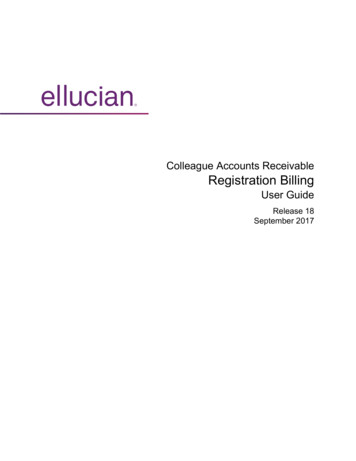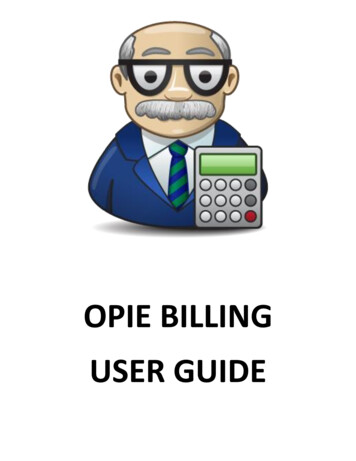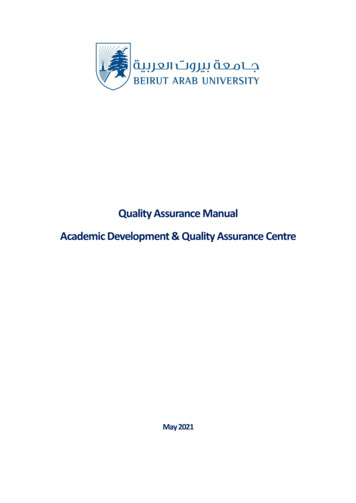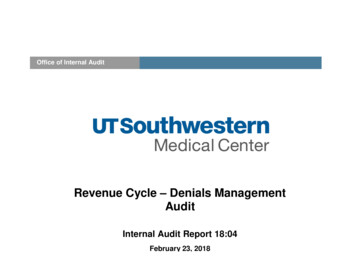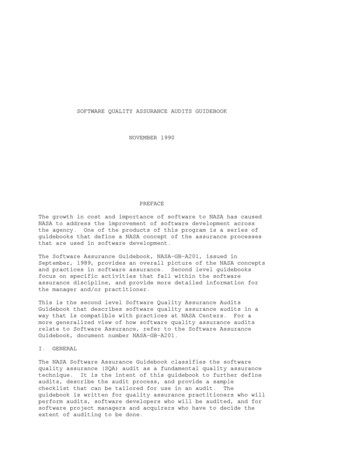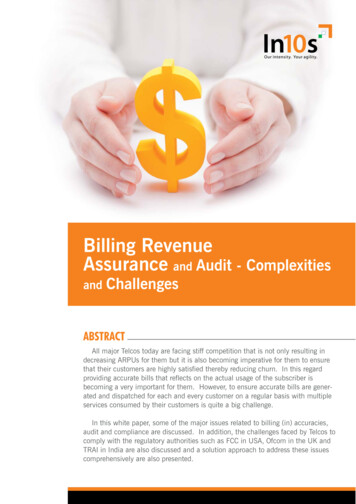
Transcription
Billing RevenueAssurance and Audit - ComplexitiesandChallengesABSTRACTAll major Telcos today are facing stiff competition that is not only resulting indecreasing ARPUs for them but it is also becoming imperative for them to ensurethat their customers are highly satisfied thereby reducing churn. In this regardproviding accurate bills that reflects on the actual usage of the subscriber isbecoming a very important for them. However, to ensure accurate bills are generated and dispatched for each and every customer on a regular basis with multipleservices consumed by their customers is quite a big challenge.In this white paper, some of the major issues related to billing (in) accuracies,audit and compliance are discussed. In addition, the challenges faced by Telcos tocomply with the regulatory authorities such as FCC in USA, Ofcom in the UK andTRAI in India are also discussed and a solution approach to address these issuescomprehensively are also presented.
White paper UniServeTM AssureTABLE OF CONTENTS01. Introduction0302. What is Revenue Leakage?0303. Where the problem is0504. Regulations of TRAI, FCC and Ofcom on billing0605. Need for Automated Billing Assurance and AuditSystem0906. Impact of non-automated Billing and AuditingSystem0907. UniServe Assure solution for Revenue Leakage,Governance, Risk & Compliance1108. Key Functionalities and Features of UniServe Assure1209. Enterprise benefits with Intense UniServe Assure1702
White paper UniServeTM Assure01INTRODUCTIONWorldwide, today’s Telecom Service Providers are grappling with problems ofrevenue leakage, customer dissatisfaction and compliance complexities arising out ofbilling inaccuracies. On one hand, when customers are over-billed, it leads tocustomer dissatisfaction and customer churn, on the other hand, when customers areunder-billed, it results in massive revenue losses for the Telecom Service Providerthereby impacting their bottom line and margins. Even a fraction of unit of currency(dollar or a rupee) error can potentially result in millions of units of currencies due tothe sheer customer base of subscribers in tens of millions across operating countriesand circles. Additionally, all Telecom Service Providers mandatorily need to complyregularly with the norms set by regulatory bodies [such as TRAI (Telecom RegulatoryAuthority of India), FCC (Federal Communications Commission, USA), Ofcom(Regulatory Authority in UK)] related to billing and ensuring subscriber satisfaction allthe time.02WHAT IS REVENUE LEAKAGE?A telecom organization's revenue chain is usually a very complex set ofinter-related technologies and processes providing a seamless set of services to theend consumer and then track the services delivered and bill the customers for theservices delivered. This long and complex chain is very often referred as RevenueManagement Chain. As the set of technologies and business processes grows biggerand more complex, the chances of failure increase in each of its connections. Arevenue leakage is typically attributed to a Telco organization when it is unable to billcorrectly for a given service or receive the correct payment. As the organization growsthe probability of revenue leakage only increases.03
White paper UniServeTM AssureA typical Revenue Management Chain pertaining to any operator across the globe iscomprised of:1. The network and the network operations ensuring the fact that the services arebeing rendered properly to the subscribers2. Operations which are associated with the delivery of this information to themediation system for processing3. Mediation systems4. Different billing systems, for example, prepaid, postpaid, interconnect androaming and5. The core process related to billing, for example, tracking, collection, dunning,and credit control.In a nutshell, Revenue Management Chain is a complex process where SYSTEMS,PROCESSES AND HUMAN BEINGS are involved and so revenue leakages are boundto happen and there is nothing like no leakage, one can only minimize the revenueleakages with a full-fledged Revenue Assurance function.Revenue Assurance (RA) has been a problem for the telecom companies since thevery early stages. Tracking of pulses, minutes, counts, bytes etc. has never been moredifficult. Another area of revenue loss is telecom fraud. Fraud can be viewed as anintentional revenue loss. One would think these would be easy for the tech-savvyTelcos. However, the truth is just the opposite. In a hurry to release new technologiesinto the market, the Revenue Assurance systems have always been lagging behind.Revenue Assurance in a Telco environment covers a wide range of technical andbusiness aspects. An RA operator needs to be aware of both OSS & BSS processesand internal dependencies to accurately decipher the revenue code.Although Revenue Assurance has always been present in the telecom parlance, ithas recently been brought to the forefront of the top managements. This is due toseveral factors including: Profits: Increasing cost pressures and decreasing margins. The high profit daysfor most Telcos are over. They all need to find alternative means to squeezehigher margins by effectively tracking their revenue Regulatory: New regulatory structure and compliance requirements whichforce the telecom operators to report their revenue accurately. Technology Innovation: Ensuring that new technologies and products areperforming as per perceived plans. Keeping up with release of newtechnologies along with co-existing legacy systems has been a big challengefor most Telcos. Mergers and Acquisitions: With increase in the number of Telco mergers andacquisitions, organizations are finding it very difficult to handle multiple BSSsystems including Billing, Mediation and Rating together etc.04
TMAssureIn a competitive market, several new and different charging options are beingintroduced continuously by the service providers, some of which may apply only to asingle customer ora class of consumers for either a definite period or an indefiniteperiod. With growing number of such options, call types and hundreds of VAS (ValueAdded Services) along with data, voice and DTH services, consolidation in one billcoupled with the sheer volume of number of subscribers (retail and corporate) aregrowing the number of billing complaints received by Service Providers andRegulatory authorities alike across the world. Despite multiple support and helpchannels, including IVR, Self-Care, SMSC codes interaction, it is becomingimperative for the Telcos to control their billing processes even more stringently andensure almost 100% accuracy, every time a bill is generated and dispatched tovarious types of subscribers – Post-Paid, Retail, Wholesale, Corporate. Unfortunately,there are many challenges that Service Providers are facing to make this happen.In general, all Telecom regulatory bodies have laid down rules for billing accuracyand very broadly are responsible for achieving the following goals:1. Bring uniformity and transparency in the procedures being followed by serviceproviders with regard to metering and billing.2. Specify standards relating to accuracy of measurement, reliability of billing.3. Measure the accuracy of billing provided by the Service Providers from time totime and to compare them with the norms so as to assess the level ofperformance.4. Minimize the incidences of billing complaints.5. Protect the interest of consumers of telecommunication services.03WHERE THE PROBLEM IS:The most debated part of revenue assurance is where to start checking, i.e. at thenetwork side, the rating side, the billing side, the interconnect side, the CRM side,etc. However, most surveys and reports state that the maximum leakage happensduring the flow of Call Detail Records (CDRs) or Event Detail Records (EDRs)05
White paper UniServeTM Assurefrom the Switch to the respective rating / billing engines. Some of the commonproblem areas are:Network Signaling problems CDRs in Switch not sent to Mediation CDRs in Mediation not sent downstream CDRs rejected by rating / billing system Wrong duration on the CDRs Incorrect Business rules Subscriber provisioning Incorrect RoutingRating & Billing Incorrect Rejection Logic Duplicate CDRs resulting in double charging Incorrect tariff plans Rating & Billing errors Late rating / billing Incorrect configurations – rating minutes instead of seconds Incorrect Disconnection04REGULATIONS OF TRAI,FCC AND OFCOM ON BILLINGTRAI’s (India) requirements regarding Auditing of Metering and Billing Systemspecify that Total Metering and Billing System reliability performance should complywith the following tolerances:06
White paper UniServeTM AssureTRAI’s (India) requirements regarding Auditing of Metering and Billing Systemspecify that Total Metering and Billing System reliability performance should complywith the following tolerances:Chargeable EventsNumber under or not ChargedNumber overchargedValue under or not chargedValue overchargedPerformance0.1% (1 in 1000)0.004% (1 in 25, 000)0.05% (1 in 2000)0.002% (1 in 50, 000)(Source: Consultation Paper on Review of The Quality of Service (Code of Practice for Metering & Billing Accuracy) Regulations, 2006, Consultation Paper No. 15 /2012)Ofcom (regulatory Authority of UK) requirement regarding Total Metering andBilling System of charges specifies that all Communication Providers (CPs) shouldcomply with the following tolerances:Usage EventsValue Overcharged (Billing)Count of Events OverchargedEvents Over RecordedInaccuracy Limits0.002% ( 1: 50k)0.002% (1:50k)0.002% (1:50k)(Sources: Notification of a modification under section 49 of the Communications Act 2003 the Ofcom Metering and Billing Direction)Other regulations that the service providers have to comply with as per Ofcom are:1. The error-rate that is allowable (e.g. 0.002% or 1 in every 50,000 of callsor other charges billed).2. A maximum amount (‘threshold’) of 600 a month in respect of overchargingallowed by CPs whose turnover is less than 360m a year.3. The procedure to be followed by CPs in the event of failures in theperformance of their metering and billing system.4. The assessment process for initial and ongoing approval.The negative reaction of subscribers upon seeing unexpected charges in theirphone bills is called Bill Shock in telecommunications parlance.For consumers and businesses that own a variety of wireless devices, deploying asolution that offers real-time monitoring and management is the only solution to avoidbill shocks.The FCC and CTIA in the United Sates, as well as Ofcom in the UK and otheragencies, like the European Union, have made numerous headlines by advocating onbehalf of consumers and businesses for protection against bill shock. These agenciesare making significant strides in terms of legislating bill shock laws, and examiningthe role the telecom carrier plays in moderating these costly, unexpected surprises.(Sources:- (1) Notification on the Ofcom Metering and Billing Direction Notification ofa modification under section 49 of the communications Act 2003 The OfcomMetering and Billing Direction 2) Notification on the Ofcom Metering and BillingDirection Notification of a modification under section 49 of the Communications Act2003, The Ofcom Metering and Billing Direction)07
White paper UniServeTM AssureAs per FCC (regulatory authority in USA) The Government Accountability Officehas reported that 34 percent of wireless phone users responsible for paying for theirservices received unexpected charges on their bills in 2008 and early 2009. And ina survey done in April-May 2010, the FCC found that 17 percent of all Americanswith cell phones – a total of 30 million people (translates into 1 out of 6 Americanshave experienced bill shock at least once throughout their lives) – had experienced asudden increase in their bill that occurred even when they had not changed theircalling or texting plan.(Source: Federal Communications Commission Consumer and GovernmentalAffairs Bureau - White Paper on Bill Shock – October 13, 2010)All the above has resulted in heavy revenue losses due to dissatisfied customerand churn, also FCC has introduced regulation to prevent Bill shock to subscribers.As per FCC, Service providers need to comply with the following:1. Alerts and Notifications have to be sent out well in advance whena. Subscribers are approaching an allotted limit for voice, text, and datausage.b. Subscribers have reached their monthly allotment limit and beginincurring overage charges for any subsequent use of that service.c. Subscribers will incur international or roaming charges that are notcovered by their monthly plans and notification if they will be chargedat higher than normal rates.2. Service Providers need to make clear, conspicuous, and ongoing disclosure ofany tools or services they offer which allow subscribers to set usage limits ormonitor usage balances, including any applicable charges for those services.3. This information should be made available in a manner that is accessible toand usable by consumers with disabilities (section 716 of theCommunications Act of 1934, as amended (Act), and the Commission's rulesimplementing sections 255 and 716 of the Act)Quality of Service which has to be maintained by all service providers pertainingto billing system should be excellent and at par to achieve 100% correctness of bill,which will in turn help them arresting revenue leakages, if any and increasescustomer satisfaction through accurate bills thereby increasing telecom operator’sbrand value. Brand Value of the service provider is severely affected by customerchurn and dissatisfied customers’ word of mouth. .08
White paper UniServeTM Assure05NEED FOR AUTOMATED BILLINGASSURANCE AND AUDIT SYSTEMRapid and far-reaching changes in the telecommunications landscape areincreasing the risk of revenue leakage. Today’s operators have to cope with complexnetwork systems, converged service offerings, multiple third party partners and a risein outsourcing, all of which create the potential for inaccurate data capture andbilling, and contribute to revenue leakage.There are many ways by which a Telco loses valuable revenue; revenue leakagedue to incorrect billing is one of the main culprits. Due to sheer size of the customerbase besides complexity and diversity in the services offered, it becomes a herculeantask for the Telco to often process and validate the bill correctly. Over billing andunder billing are the main outputs of such system which in themselves cause revenueleakage.Bill Run Delay is one other factor causing revenue leakage. With a delayed BillRun, collections are impacted that directly result in Revenue loss. When a customeris added into the Billing System, the system assigns the customer a predefined BillCycle. A bill cycle is a date on which the Billing Engine runs and produces bills for aset of customers. If customer is assigned to the bill run date of 1st of the month, thisis called customer's nominal bill date. But because of various reasons, many timesbill run is delayed and actual bill gets generated on a later date, this is called actualbill date.06IMPACT OF NON-AUTOMATEDBILLING AND AUDITING SYSTEMIn the overall scenario outlined above, it is imperative for Telecom ServiceProviders to employ a well-defined, systematic plan for the continuous monitoringand reporting of the risk of loss, or the actual revenue loss within the billing system.Also, apart from meeting compliance norms, physical auditing for leakage09
White paper UniServeTM Assureidentification and containment ensures to some extent that billing is correct andconsistent and helps establish a “company you can trust“image and aids in customerretention. However, the entire process of manual audit in which the bill computationsare checked is tedious, manpower intensive and error-prone.In the absence of specialized tools designed for auditing of metering accuracy,Telecom Service Providers have been forced to rely on manual processes orhome-grown solutions. Though these measures control the billing accuracy to someextent, they are still NOT altogether reliable. Some of the issues faced by such ad-hocchecks and balances are:1. Manual Processes: Resource intensive, complicated and error-prone, muchskilled labor is needed to manually check the bills. Further, growing subscriber basesmean that the sample sizes of manual checks also grow with every Bill cycle! Thisresults in prolonged, error-prone and tedious manual bill checking and heavydependence on incremental resources.2. New Product Implementation: Frequent launches of newer bill plans,packages, price schemes, etc. result in a need to refer to multiple systems to checkand implement the changing audit policies. This makes the process of manualauditing tedious as complex combinations of services used by customers need to becalculated.3. Complexities in Computation and Validation: Different pieces of the billinginformation are available at different sources and it needs complex calculations toarrive at the correct cumulative figure. Manual process of referencing differentsources of bill data and carrying out these activities is, once again, tedious anderror-prone.4. Sample Coverage: Due to short and stringent bill cycle window times only asmall sample is audited as manual auditing is highly time-taking and resourceintensive; this small sample cannot be considered an adequate measure of leakagemanagement and containment5. Tracking Human Error: Due to lack of an automated system, it is an arduoustask for the auditors to track and measure, keep record of the errors that aregenerated, and difficult to route errors to concerned supervisors / managers.Individually and cumulatively, all these lead to longer Turn-Around-Times forcorrections and it becomes very tough to identify corrective measures to curtailleakage.The impact of non-automated or manual billing and Auditing system can besummarized as follows: Incorrect rating of billing systems can cause approximately 10%* of revenueleakage Compliance to the stringent regulatory requirements for metering and billingaudit norms becomes a nightmare10
White paper UniServeTM Assure Inconsistent billing leads to increasing customer dissatisfaction and churn. Dependency on domain experts, becomes both expensive & time-consuming Configuration Issues in Bill Plans arise frequently Over-billing issues, dissatisfied customers are not uncommon Under-billing issues resulting in revenue leakage, tax problems Low / small sample size because of time constraint Possible errors on unaudited portions of the subscriber base Verifying business scenarios - Complex challenge07UniServe ASSURE SOLUTION FORREVENUE LEAKAGE, GOVERNANCE,RISK & COMPLIANCEIntense’s UniServe Assure (Billing Revenue Assurance and Audit System) is arobust and dependable solution for improving revenue assurance of a Telecom ServiceProvider. Assure addresses the management of revenue assurance by automating andmonitoring of post-cycle revenue assurance and ensures efficient leakageidentification and containment, cost effective and 100% reliable.Built on SOA (Service Oriented Architecture), the solution effectively caters to thecomplexities of subscriber bases, clustered rules of bill plans, and schemes forvalidation and ensures bulk indexing of values to the external database for generationof reports.The application aims to ensure that billing systems and those functions that feedinto the billing process are accurate, as well as meet all relevant regulatoryrequirements. It encompasses the totality of all equipment, data, procedures, rules,configurations and activities used to determine the billing charges for provision andusage of Electronic Communications Services. These accurate and metered chargesare then presented on End-Users’ Bills. In other words, UniServe Assure assists andensures that all the compliance parameters established by telecom regulatory bodiesare fully met in a reliable and consistent manner.11
White paper UniServeTM AssureUniServe Assure incorporates all processing steps required by the telecomprovider to prevent Revenue Leakage for the end customers and empowersconsumers with simple alerts and makes sure they are never billed incorrectly. It alsoempowers them with information enabling them to make smart decisions about theirmobile plans.08KEY FUNCTIONALITIES AND FEATURES OFUniServe ASSURE FOR RESOLVING THE PROBLEMSFACED BY SERVICE PROVIDERS WITH ISSUESPERTAINING TO TMBSRevenue LeakageAs explained above there are many ways by which a service provider loses one ofthe most valued assets, that is revenue. Below section points out how automation ofbilling system by UniServe Assure helps arrest these leakages.UniServe Assure automates the key telecom billing related functions such as: Call Data Record (CDR) Guiding Rating application BillingUniServe Assure contains below mentioned functionalities /modules to achievethe desired goals of complete automation:1. IDM – Intelligent Data Manager2. Audit Sample Selection3. Plan Configurator4. Alerts and Notifications1. IDM (Intelligent Data manger) and Bill Run Assurance : IDM captures all the CDRinformation through adaptors and inputs them into the system. CDR information likedetails of the call, start time of call, end time of call, duration of call, originatingnumber and terminating number are captured and fed into the system automaticallywithout any human interference.12
White paper UniServeTM AssureBill Run Assurance: There are many sub features to this functionality, they are:a. Input data handler: The system accepts varied data sources like ASCII Text files(Fixed length, delimited and tag based), XML and Input stream from a Database/Datalookup (ODBC, Oracle, DB2, SQL Server, MySQL) simultaneously.b. N Level Support: The system writes a process ready input file for auditing bytaking input from above mentioned varied sources and generates output in parent andchild format.c. Data Formatting: The system supports Data Formatting features at the inputhandling level like elimination of unwanted data, data transformation (dataalignment, prefixing, suffixing, defining the length of the object, replacing the dataobject with a given value or string, enabling decimal places and rounding-offs,converting numbers to words with trim options, converting various date time formats,adding punctuations, adding separators and deleting unwanted lines in a spool file),addition of intelligent flags, addition of Customer breaks/Page breaks,date/text/numeric formatting, tagging variable data, conversion of variable data into atabular format.d. Metadata capture at input level: The system supports metadata capture forreconciliation reports at input level and captures metadata into pre-defined externaldatabases for reporting, while processing the input from varied data sources.e. Formatted Files: The system supports generation of customer-wise formattedfiles and consolidates data of different customers into one single formatted filef. Template designer: The system supports GUI based templates to specify theinput type (ASCII Text files, XML), input path, set of rules, output type (TXT, CSV) anddynamic output path applicable for a line of business (LoB) or basis the requirements.g. Business Rules Engine: The system supports GUI based configurablebusiness rules engine to define various charging and discounts rules. The systemsupports GUI for definition of conditions on the data objects of various data types.Validation of all the bill entities:The application supports validation of the following bill entities and the respectivescenarios through configurable GUI:a.Recurring Charges - Apportion & Non-apportion Advance, Arrears, Bill CycleChange - Stretch & Shrink, Rate Override, Combo Parameters based Charging,Refund & Discount claw back, Activation and Disconnection of servicesb.One-time charges - Normal Charging, Rate Override, Parameter based Chargingc.Other Credits & Charges - Adjustments, Waivers, Regular OCCsd.Promotions - Explicit & Implicit Discounts covering scenarios like Absolute,Relative and Tiered discountse.Free Units Packs - Implicit, Explicit, POFU and POFUL13
White paper UniServeTM Assuref.Customer Name & Address, Account Numberg.Bill-Date, Bill-Period, Due Dateh.Previous Balance, Payments, Current Charges, Total Amount Duei.Messages on the invoice (appearing in BCH and/or BGH output which will be aninput to the application).The system identifies and highlights the over-billing and under-billing cases alongwith the impacted customer id/Service Id for quicker resolution of the issue.Some of the key characteristics of IDM are:1.High Scalability: The system supports horizontal and vertical scalability2.Proforma processing: The application is able to process a single or multiple filesin Proforma (test) mode to ensure that the configurations & the output are as perthe business requirements3.Security: The system supports application access only to authorized users4.No limitation on the pre-bill audit sample: There's no limitation on the samplesize (total input files) for pre-bill audit.5.Exception Handler at Processing Level: The system handles exceptions in theevent of errors such as DB disconnection, incorrect folder and write permissionsetc while processing6.Output Report: The system supports consolidation of data from varied datasources, writes various output formats such as ASCII Text, XML, CSV and Indexesthe output to another database. The system supports a GUI for defining thestructure of the output file for Header, Body & Footer.7.The system has the flexibility to check the computed value with multiple sources- Bill and/or Rate Plan value2.Audit Sample Selection:Audit Sample Selection module allows selection of various subscribers who would betaking part in the pre-bill audit by a criterion. These selected subscribers will bevalidated by the system as per their plans and ensures correctness in billing. Serviceproviders can select the subscribers as per the criterion laid by the regulatoryauthorities. For example, the audit criteria defined by TRAI and followed by UniServe Assure are:1.Audit should be done on a sample basis taking into account plans that havemore than 10% of total subscribers in each licensed service area, subject tomaximum of 10 service plans per licensed service area.2.Apart from the above, two post-paid tariff plans, having the largest number ofsubscribers, shall also be covered in audit14
White paper UniServeTM Assure4.Includes more number of tariff plans which are launched during the year5.Two post-paid tariff plans launched during each of the half year of audit that hasthe largest number of subscribers may be considered for auditOther Audit criteria that can be selected are listed below: Rate Plans - lists all the available Rate Plans Service Packs - lists all the available Service Packs Services - lists all the available Services Promotions - lists all the available Promotions Free Unit Packs - lists all the available Free Units Packs Free Unit Packs (COFU/POFU) - lists all the available Free Units Packs(COFU/POFU) Movements - Upgrades/Downgrades Newly activated Contracts Suspended Contracts De-activated Contracts Re-activated Contract. Customer Groups - lists all the available Customer Groups Suspended Customers De-activated Customers Re-activated Customers Newly activated Subscriptions Customers who changed their rate plans Specific entries (Individual input / Bulk upload using CSV) - Service Id, CustomerId, Customer Code.3.Plan Configurator:This module feeds all the different plans that are present in the system and are beingoffered or in-service by the service provider in a single repository which is then usedto audit the bill against each customer to check bill correctness. Rate Plans,Promotions, Free Units Packs are stored in the repository15
White paper UniServeTM AssureRate Plans will include: Rate Plans Service Packages ServicesFree Units Packs will include: Promo Pack Promo Rule Promo Mechanism Promo Criteria Tiered Discount Zone Logical Zone4.Alerts and Notifications:There are various types of alerts that can be configured into the system, which helpthe Service provider to adhere to the regulations laid down by the regulatory bodies.These alerts also help the subscribers to know the status of their accounts and alsoalert them in many scenarios.With these alerts the subscribers can avoid bill shocks. Informed customers withproper alerts can decide what plans they may choose in different scenarios. This isbeneficial for the service provider too, as subscriber will not avoid using the servicein many scenarios (Ex. Roaming) which directly means revenue loss. Without alertsbill shocks become more frequent resulting in dis-satisfied customers leading tochurn and bad reputation for the brand.ReportsSome of the reports that UniServe Assure provides to subscribers are:1.Usage alerts and related information that will assist them in avoiding unexpectedcharges on their bills.2.All consumers have access to baseline information to help them manage thecosts associated with mobile service in an informed and timely way to avoidunexpected charges.3.Establishing a precise usage level at which this initial notification message wouldbe triggered.4.Notification messages to consumers once they reach their monthly budgetedlimit and begin incurring overage charges.16
TM5.When a consumer is about to exceed the established monetary or volume limitfor a voice, text, or data plan, the provider would be required to send a one-timenotification explaining that the consumers are about to incur charges for servicesin excess of their normal rates.6.Notification messages to consumers when they are about to incur internationalor other roaming charges in excess of their normal rates.7.Balances information and Capping option information8.Offer consumers the ability to set limits on voice, te
to billing system should be excellent and at par to achieve 100% correctness of bill, which will in turn help them arresting revenue leakages, if any and increases customer satisfaction through accurate bills thereby increasing telecom operator's brand value. Brand Value of the service provider is severely affected by customer




